AMD Radeon Fury X
The most obvious thing you notice when you open up the Fury X is that closed loop liquid cooler attached to it. AMD first did this on a smaller scale with the R9-295×2 design. Feedback was very positive and significantly better than the criticism leveled at the R9-290X’s air cooler.
The radiator uses a 120mm fan and the tubes are long enough to reach most parts of a case where it could be mounted.
Sleeving helps to keep everything looking clean and makes this GPU by far one of the most attractive designs we’ve ever seen from AMD.
The second thing that you notice is just how small the GPU itself is. HBM integrates the memory into the main GPU chip and so the PCB really only has to support the voltage regulators and the display outputs.
The top cover can be removed the the closed loop liquid cooler combined pump and cooling block can be seen in the center with the cooler master logo on it. Unlike the R9-295×2 however this cooler also cools the VRMs which is why there is no additional fan on the card.
This is really pretty cool and should have definite advantages over an air cooler, particularly as cards get sandwiched together. The downside however is that it adds more to the price. Water coolers will replace all of this anyway and so to them it’s a waste of money. The whole system is quite compact:
Once you run multiple cards it might get to be quite an elaborate setup inside a case.
The backside even includes a backplate which is a nice touch – sadly the stickers do ruin the look a little:
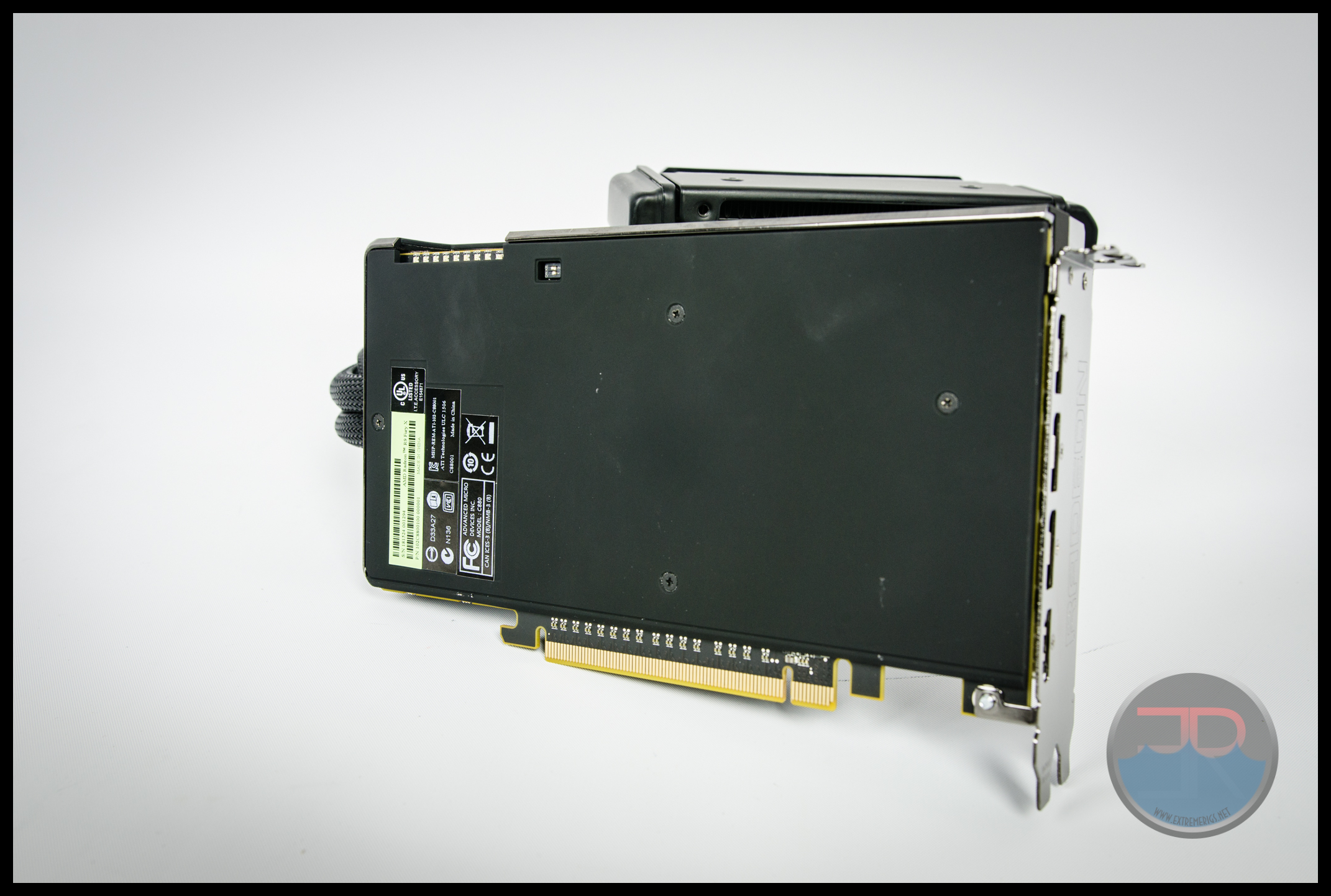
We love that AMD are the first company to ditch the aging DVI port. The Fury comes with three full size display ports (1.2a) and a HDMI 1.4a connector. Sadly this is not HDMI 2 which would be necessary for 4K/60.
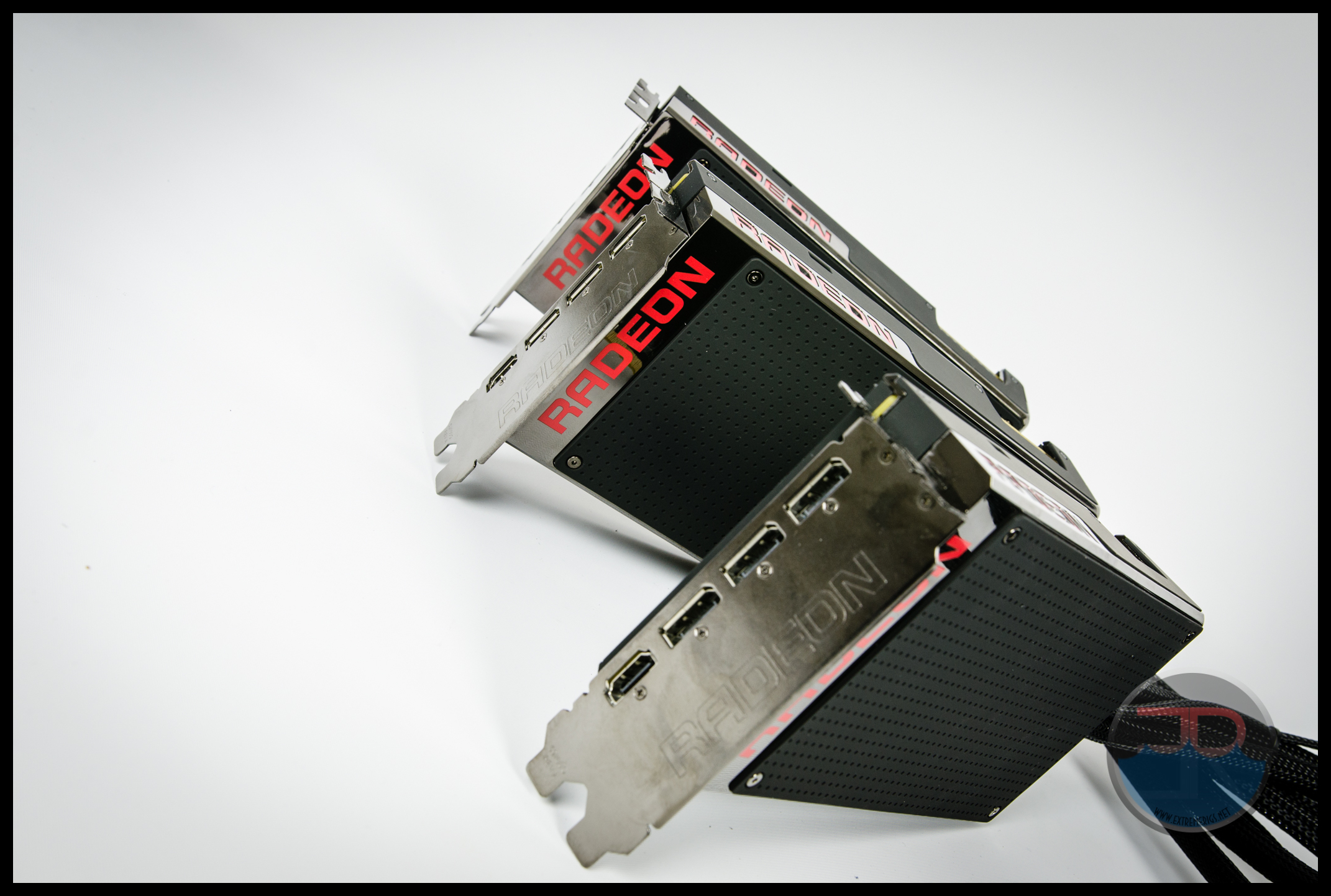
We are surprised that AMD didn’t give this flagship product more display ports. AMD’s Eyefinity technology allows for up to 6 displays to be connected together for gaming which is an advantage over Nvidia’s 3 display “surround” technology. AMD however only allow the displays to be connected to one GPU and therefore no matter how many Fury cards you have you will not be able to run a 5 display portrait setup for example. For that you have to use the R9-295×2 or 7990. Hopefully the Fury X2 will amend this.
The radiator itself seems to be quite nonrestrictive for airflow:
I.E. the fin count on each row is quite low and of a simple design. This should help mitigate dust build up over time.
Power is delivered via 2×8 pin connectors – a cool feature added by AMD are surface mount LEDs on the backside of the PCB underneath the connectors that light up depending on how much power the card is using: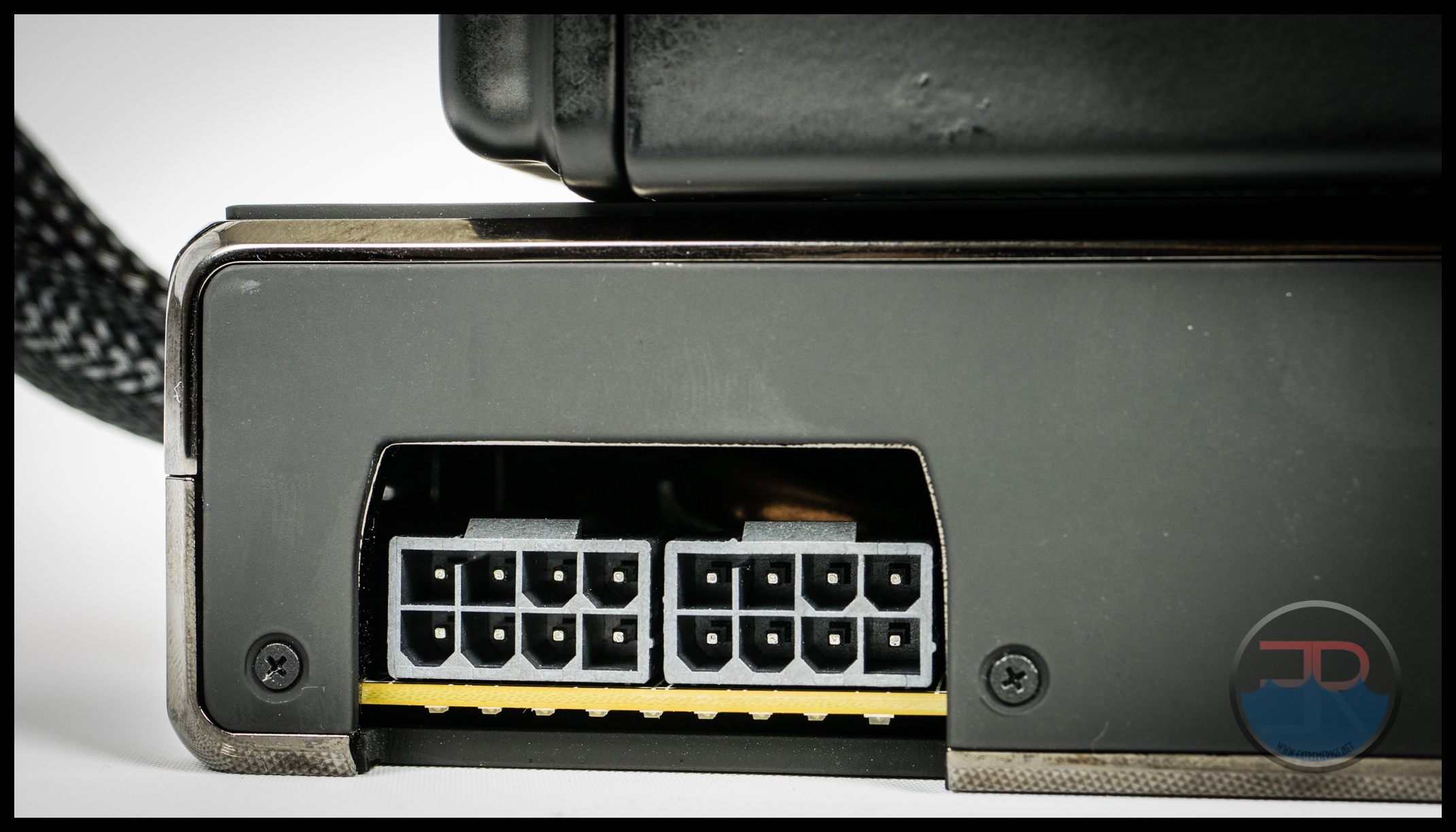
So overall the Fury X is a cool card with a new look and some new features from AMD. Now lets take a look at the Titan X.
Nvidia Titan X
The Titan X box is imposing. While the Fury X is more loudmouthed in it’s presence the Titan goes for a classier more subtle look. It means business, but it doesn’t need to tell you that.
The air cooler on the Titan X is very similar to the original Titan’s air cooler (and plenty more GPUs in between) with a few tweaks to make it look more special:
The fan is a traditional blower type that sucks in air from inside the case and exhausts it out the rear of the case. It’s not the quietest design, but it’s great all-rounder design that will work in more setups than some of the more elaborate non reference air coolers.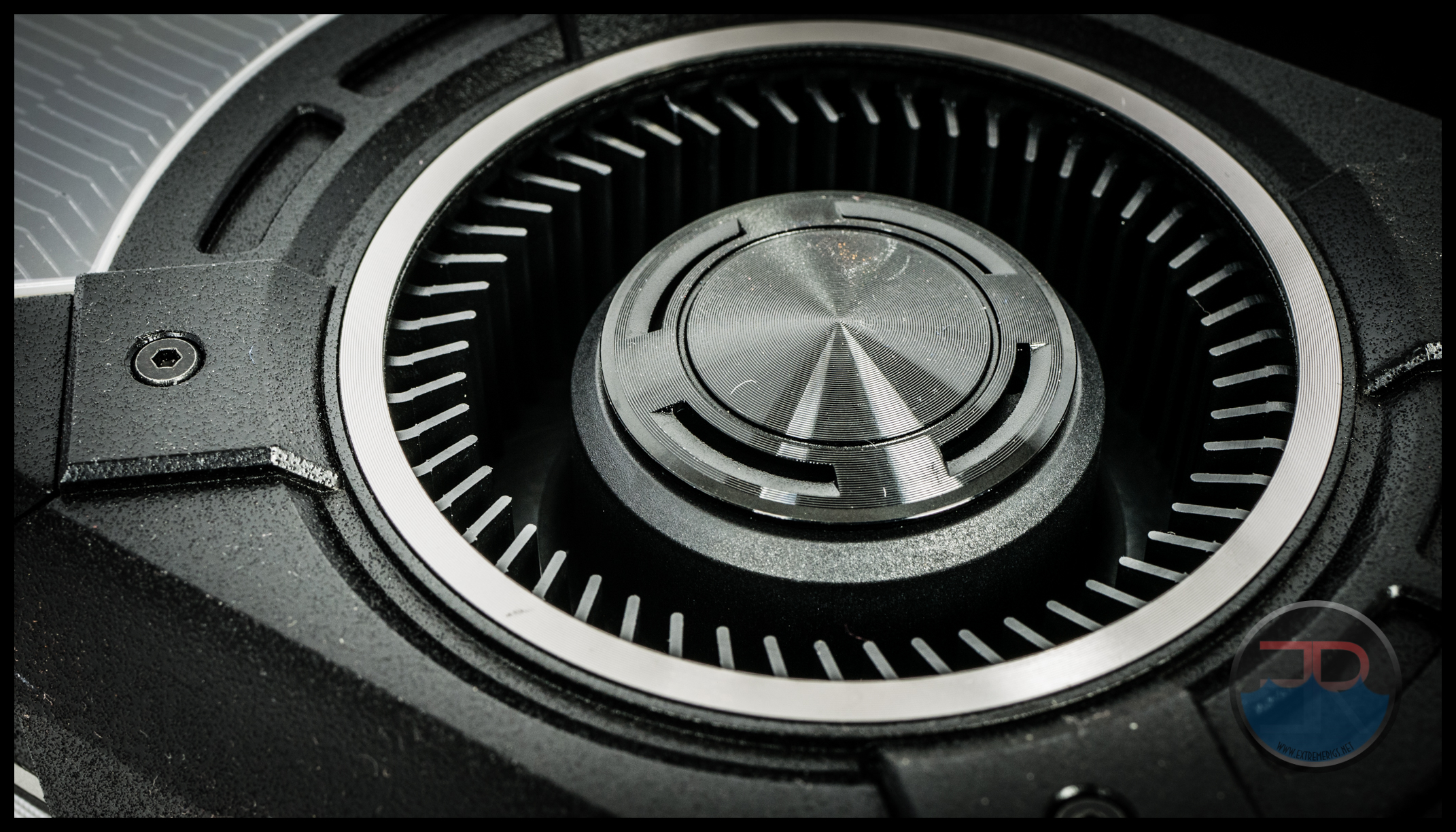 In order to get the most out of the Titan X you really need to get it under water. As we decided to run the Titan X under water in order to get the most performance we’ll be showing the GPUs as they were used:
In order to get the most out of the Titan X you really need to get it under water. As we decided to run the Titan X under water in order to get the most performance we’ll be showing the GPUs as they were used:
As EK won our last water block roundup it was only natural that we should use their water blocks for this test. These photos were taken after testing which is why there is some residual coolant in the blocks:
The display outputs are similar on the Titan X to the Fury X with one obvious difference:
Yes – there is a DVI port. This will please those with legacy displays, but those spending $1000 per GPU are usually using a display with a display port. There is a less obvious difference too. The HDMI port is v2 meaning it can handle 4K@60Hz – great for driving those high end TVs.
Alongside the waterblocks we also used EK’s excellent backplate which helps to lower VRM temperatures further. Lower temperatures mean higher clocks and lower power consumption in the GPU itself.
Power is supplied through the more common 6+8 connector setup.
Lining up the GPU’s next to each other it’s easier to see the size difference:
The Fury X is simply substantially smaller at the card level. However the total package may end up larger once you factor in all the tubes and radiators.
Now let’s see how well the cards perform!









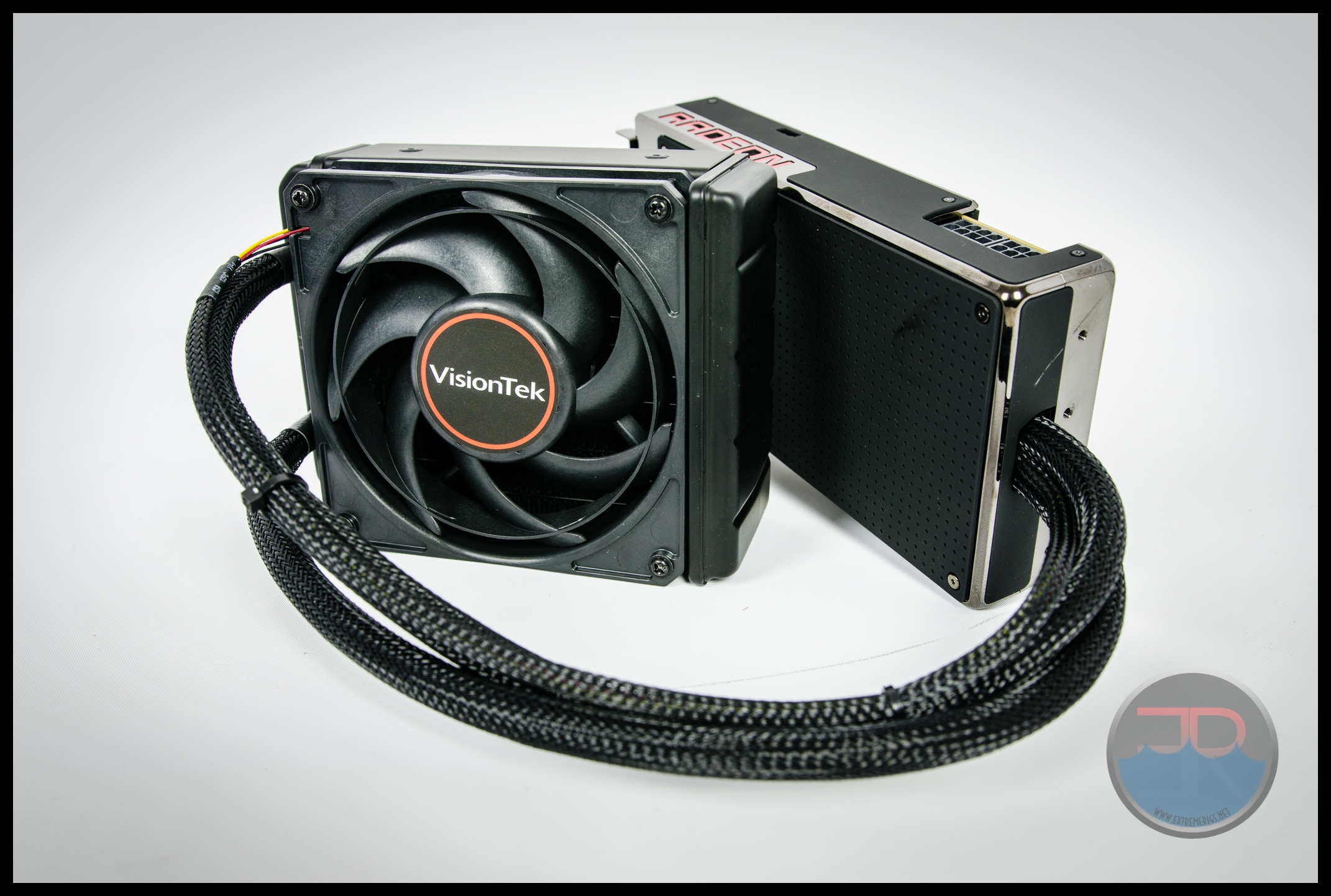
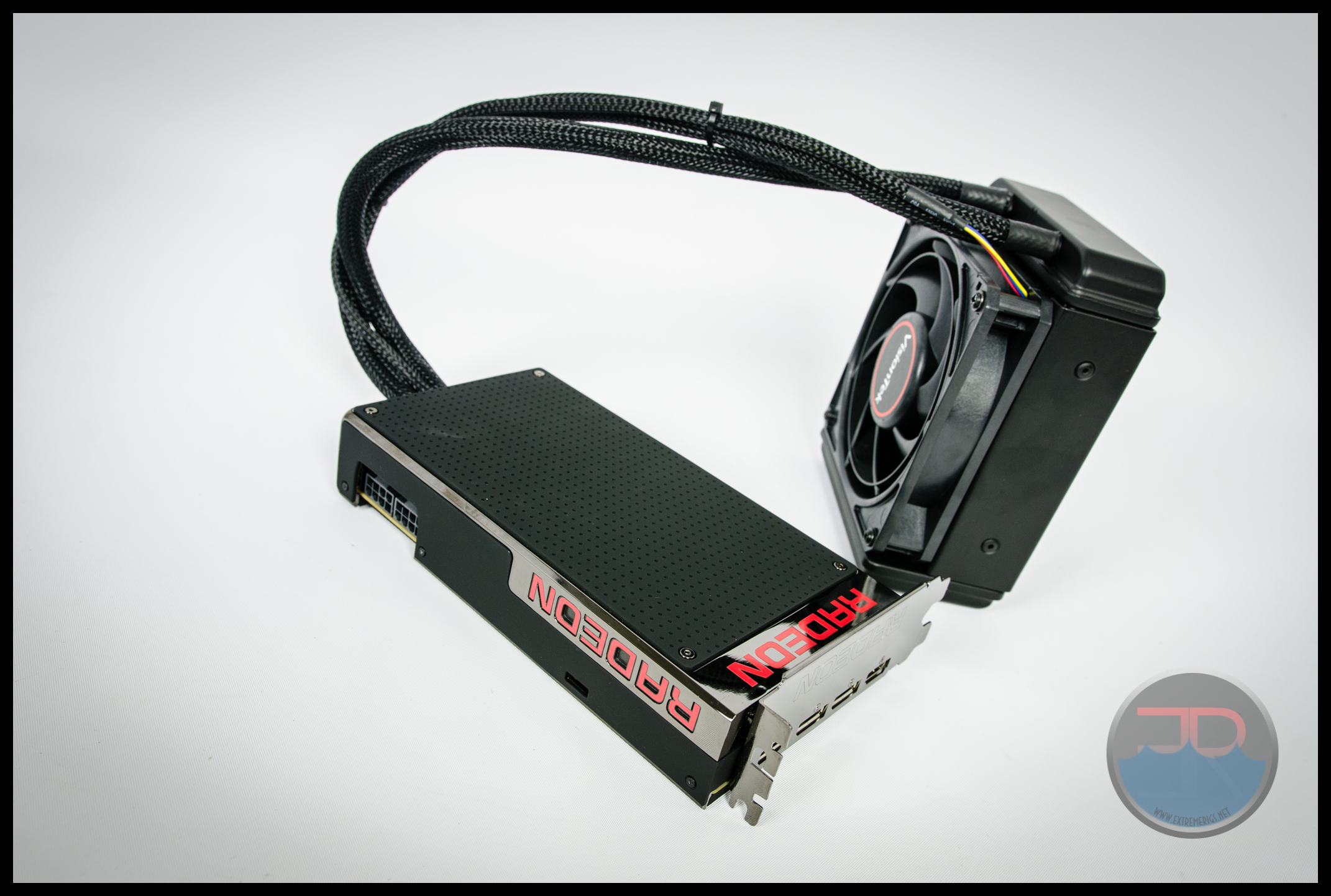
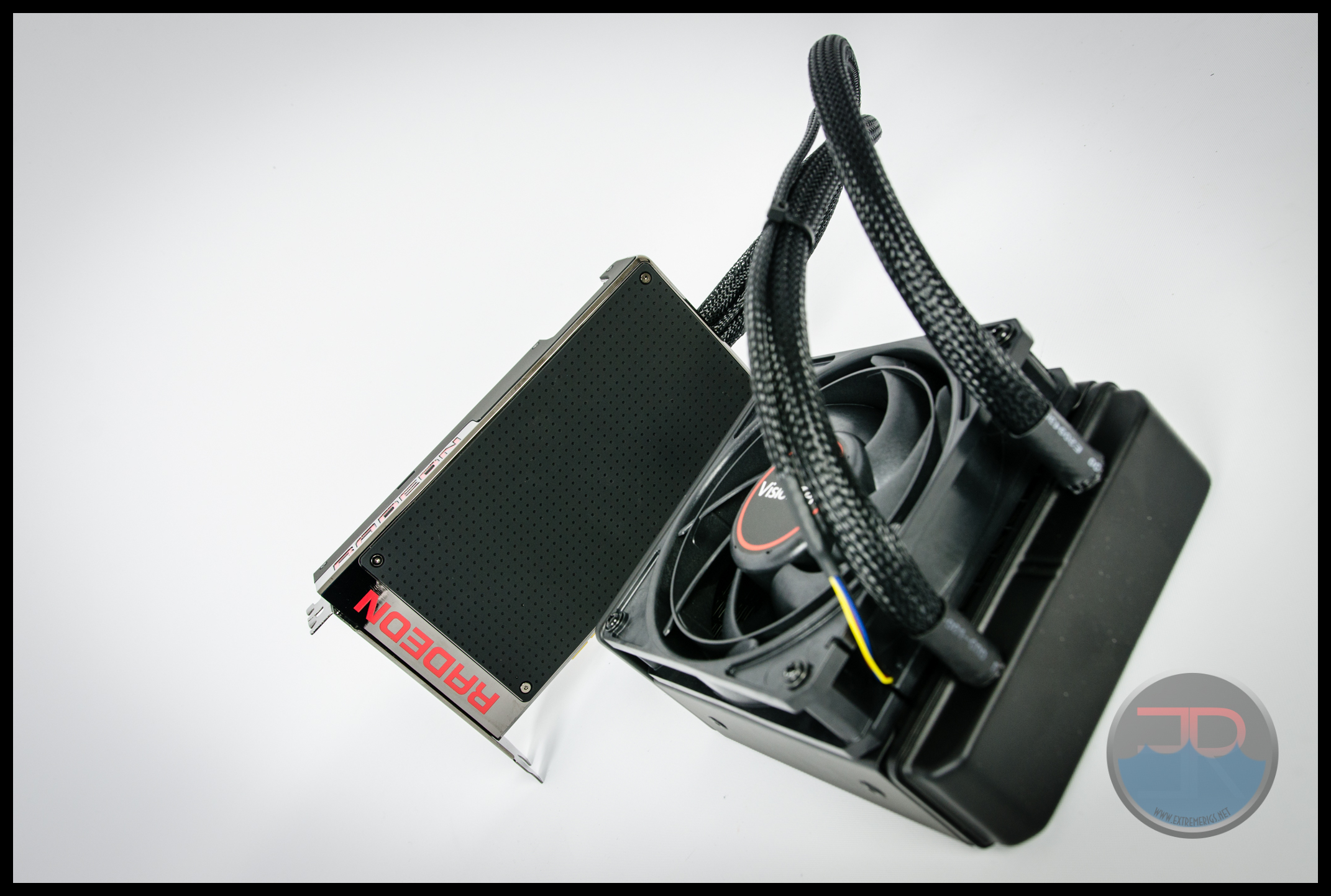
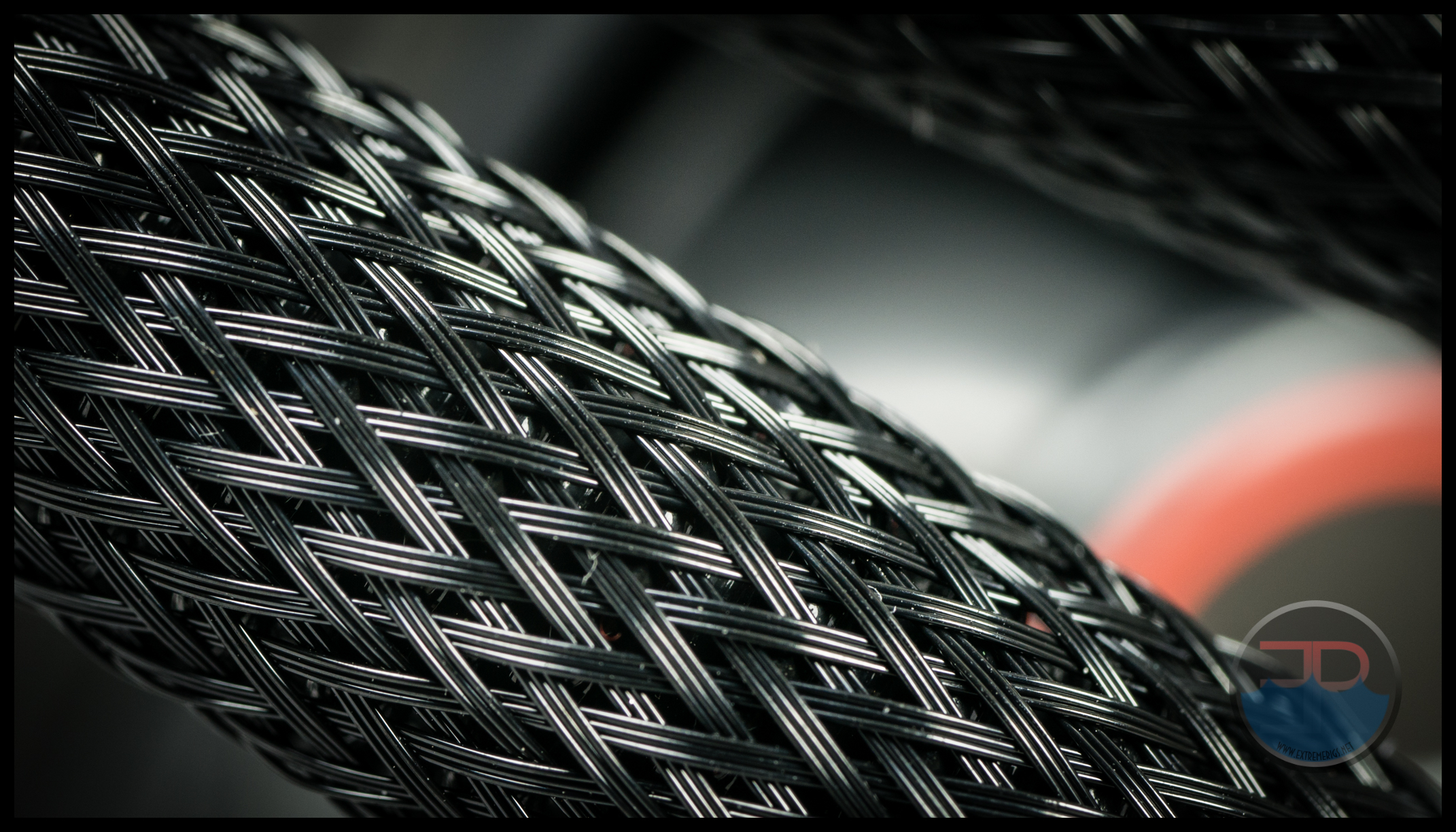
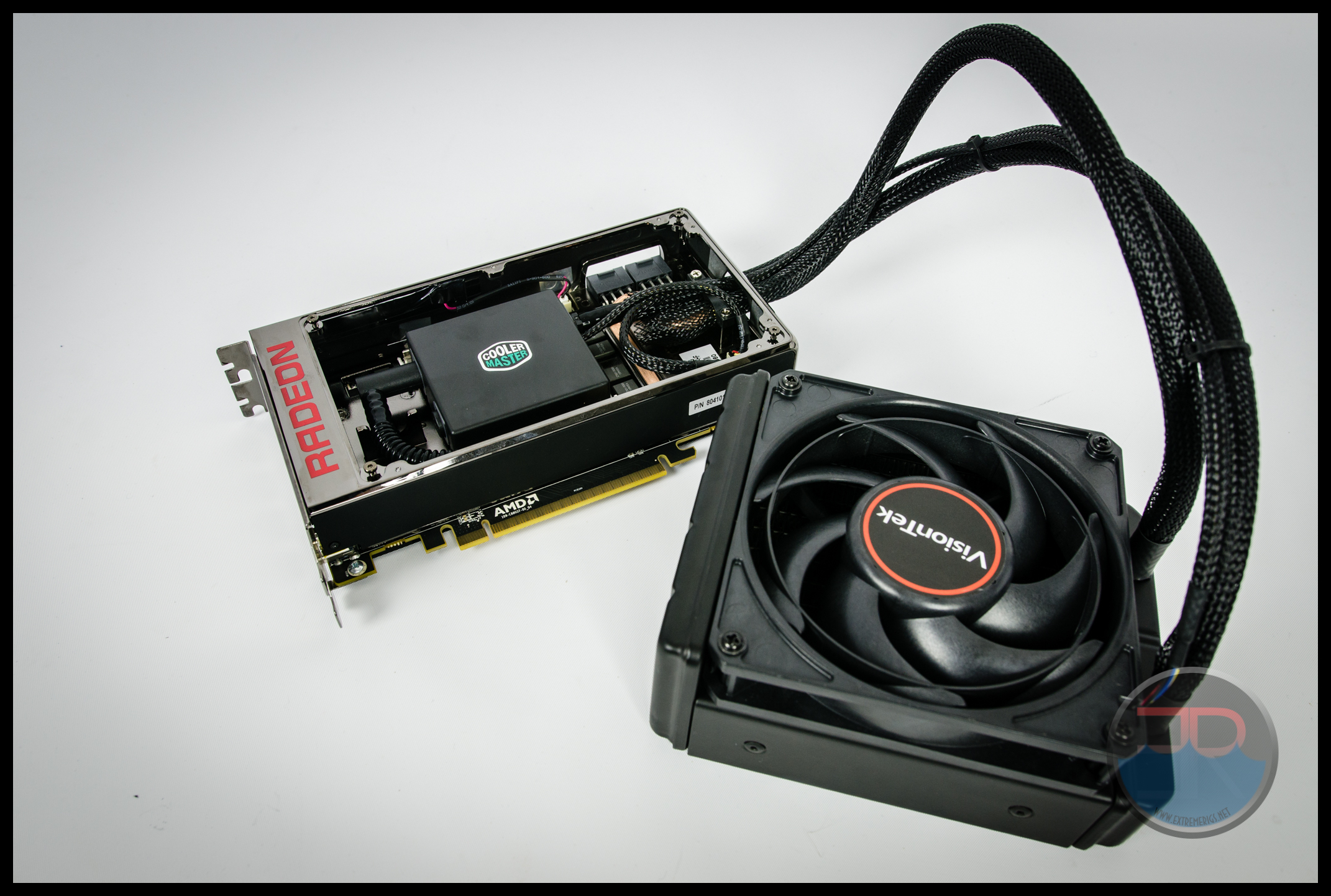
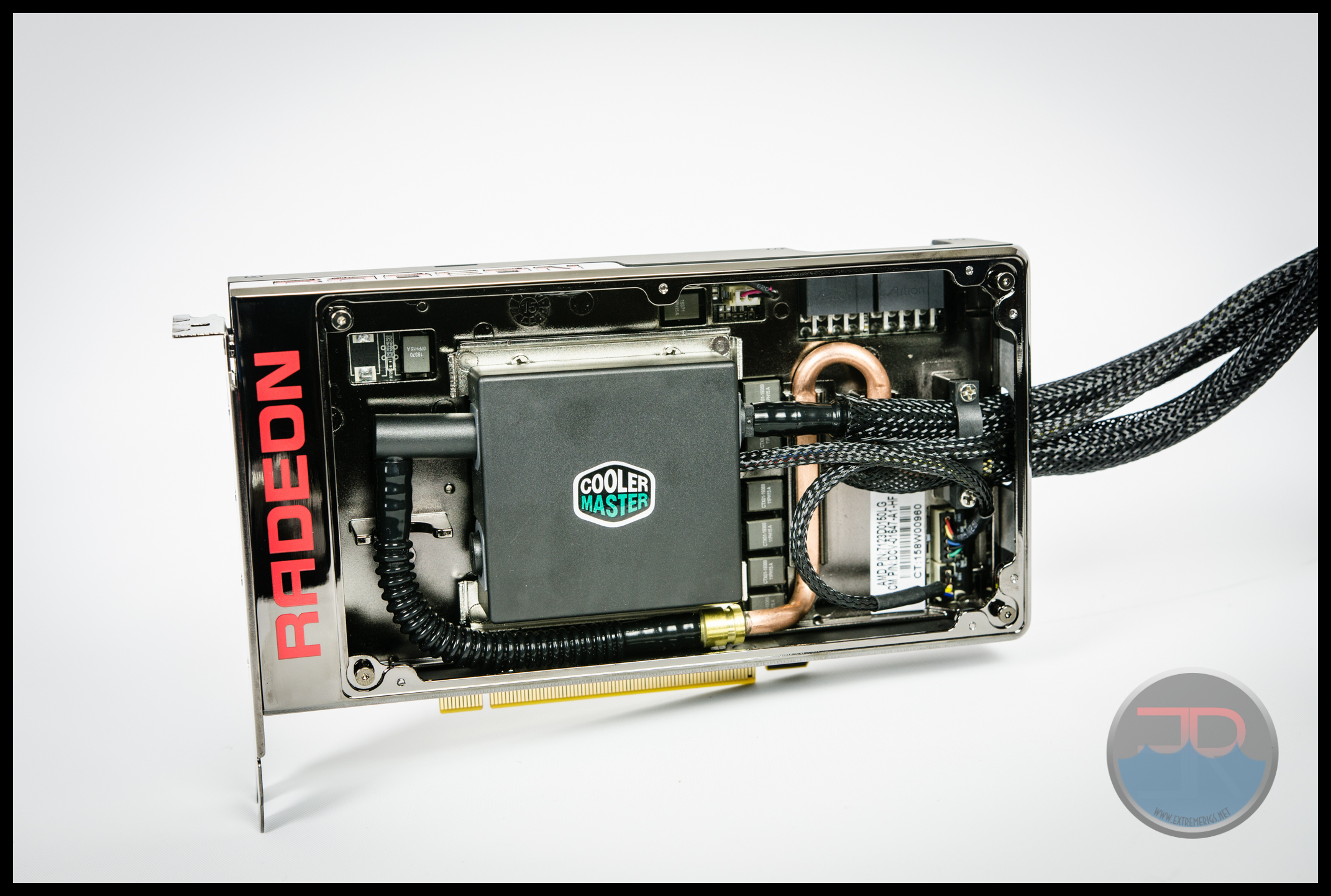
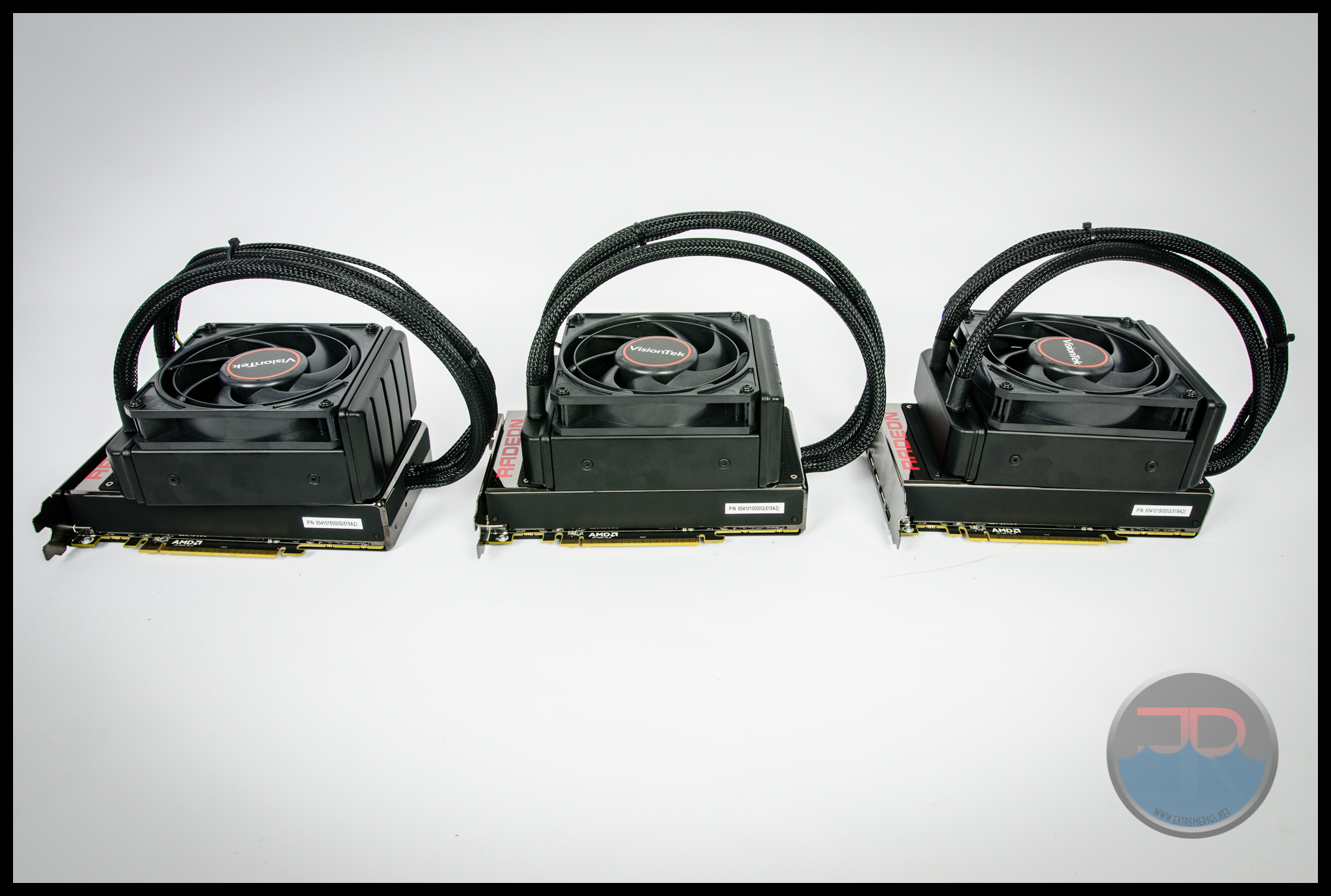
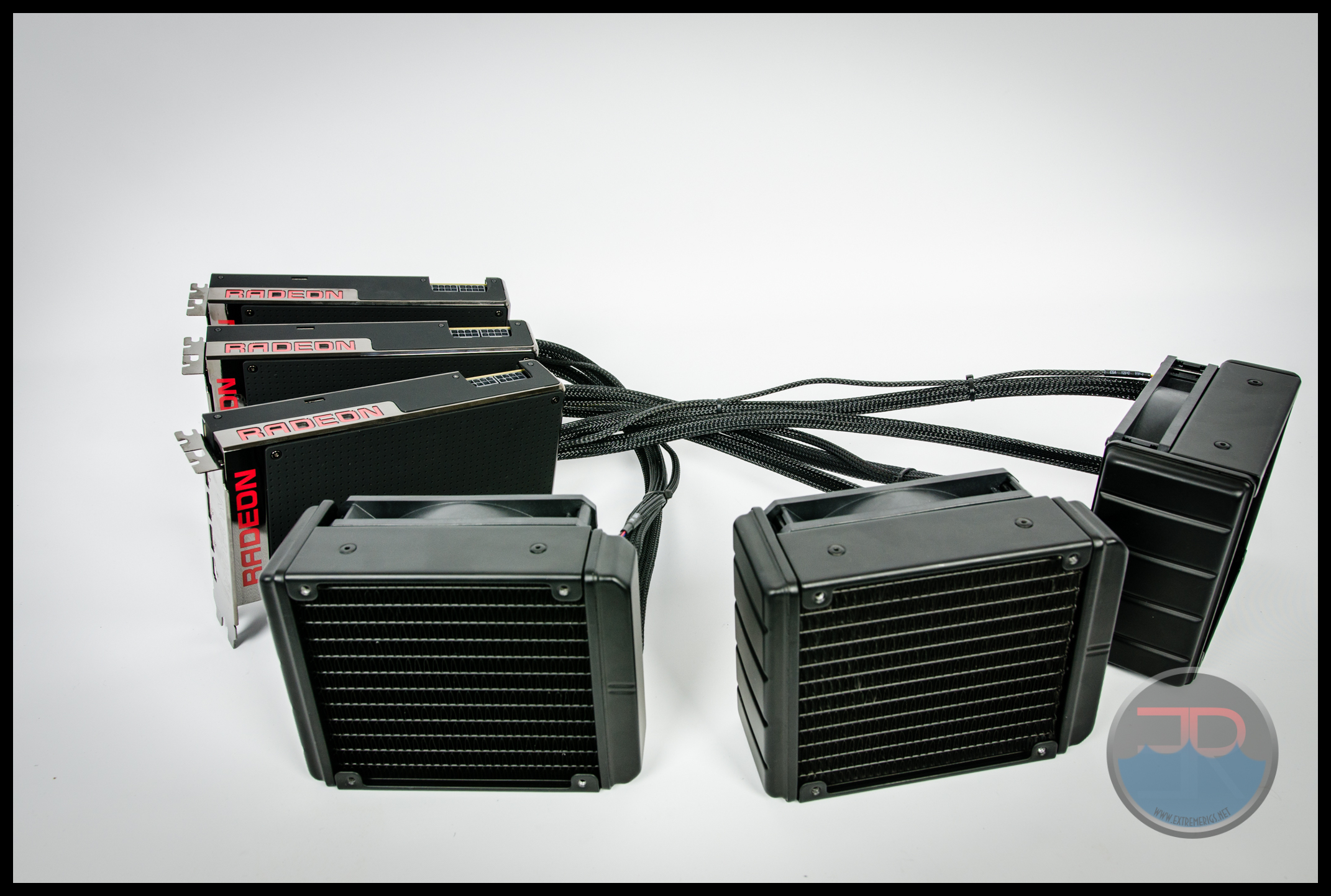
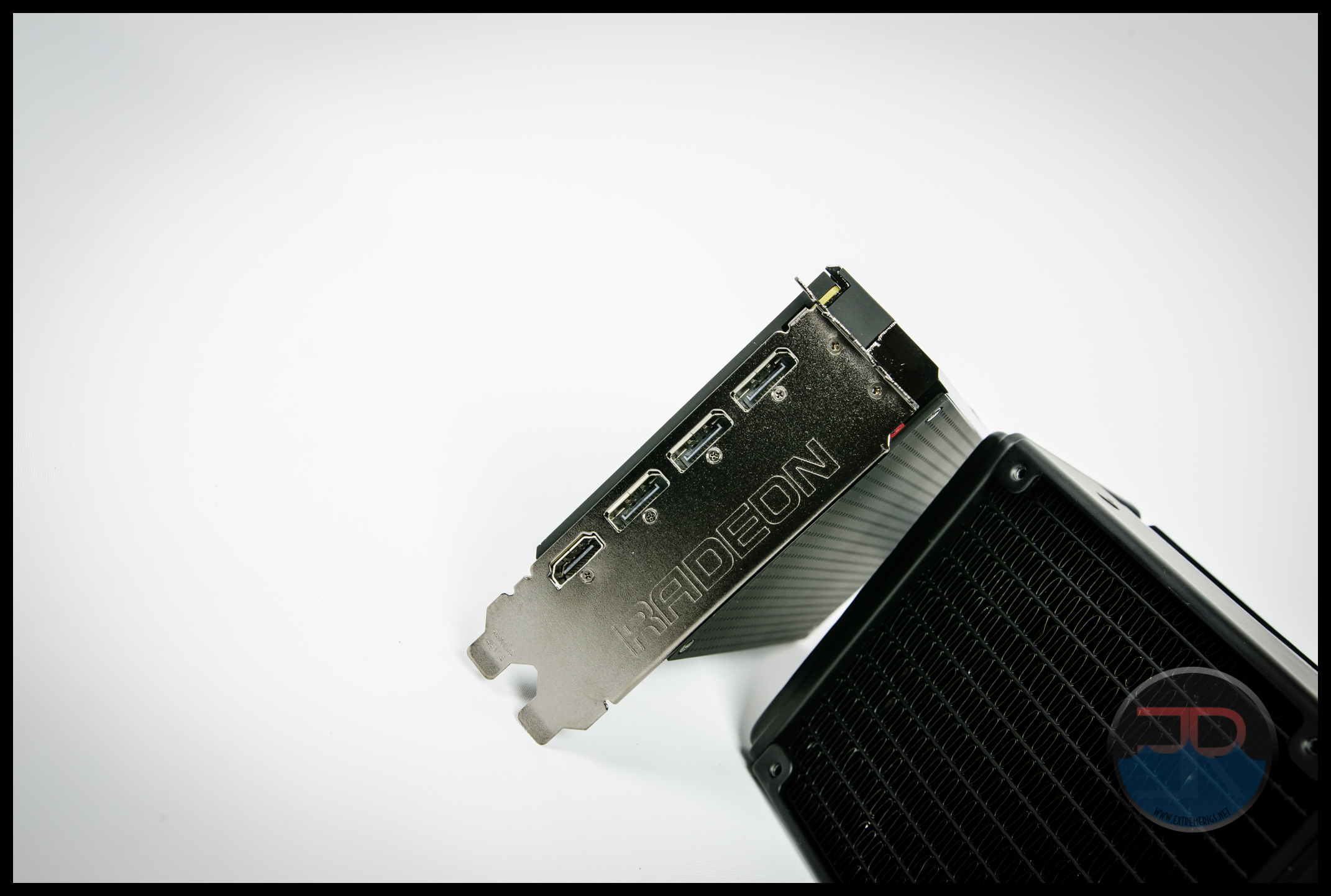
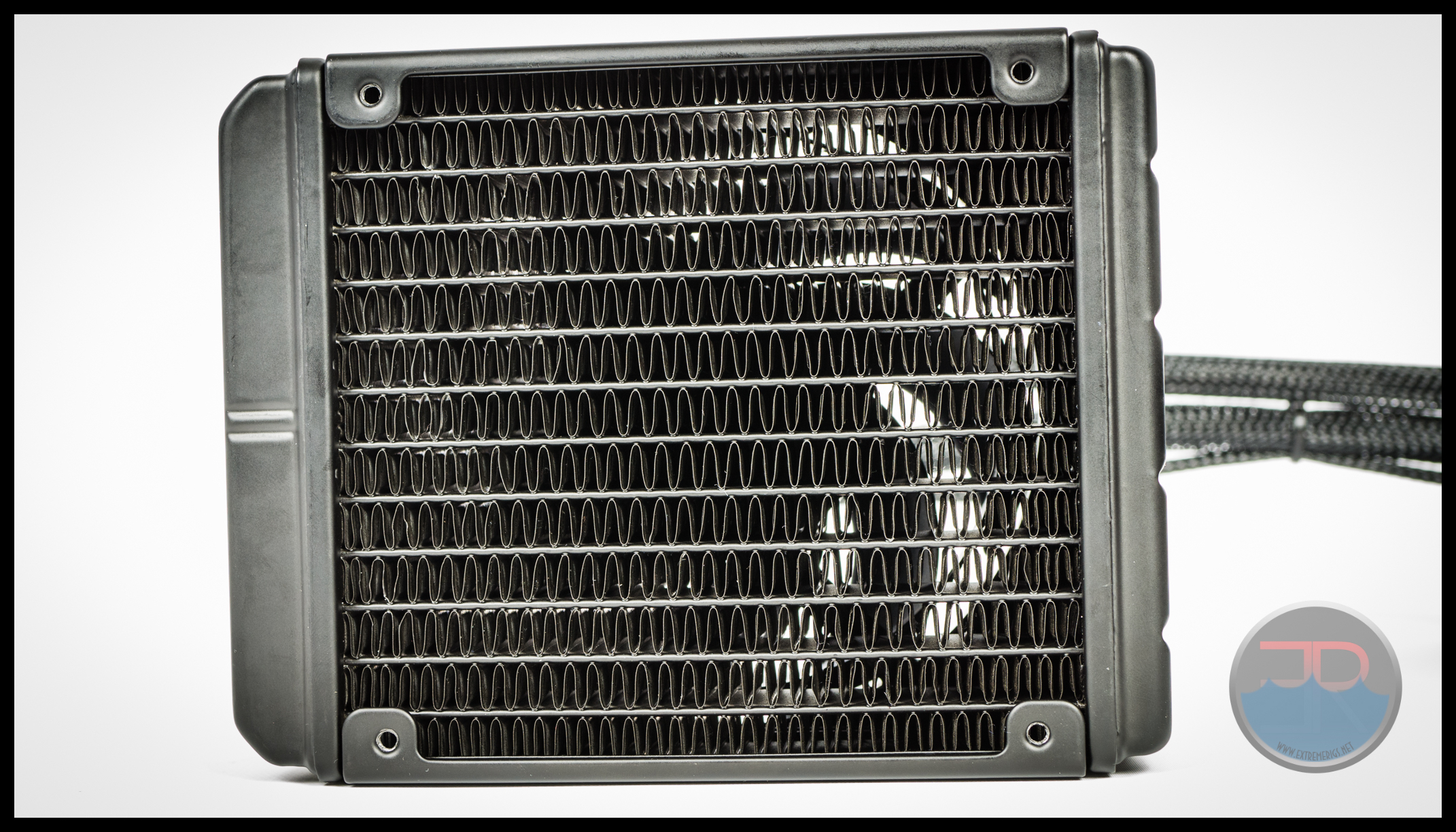
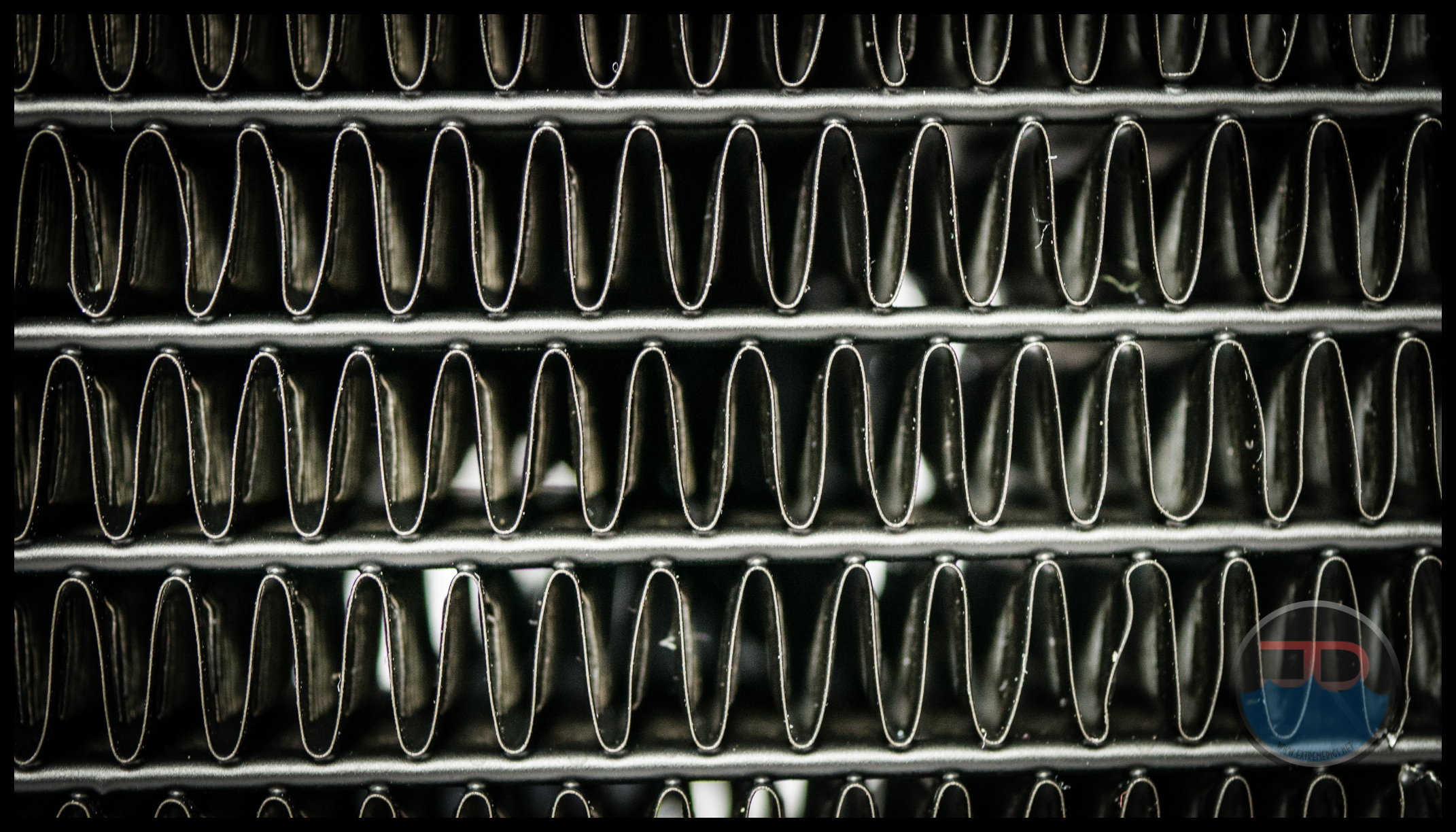
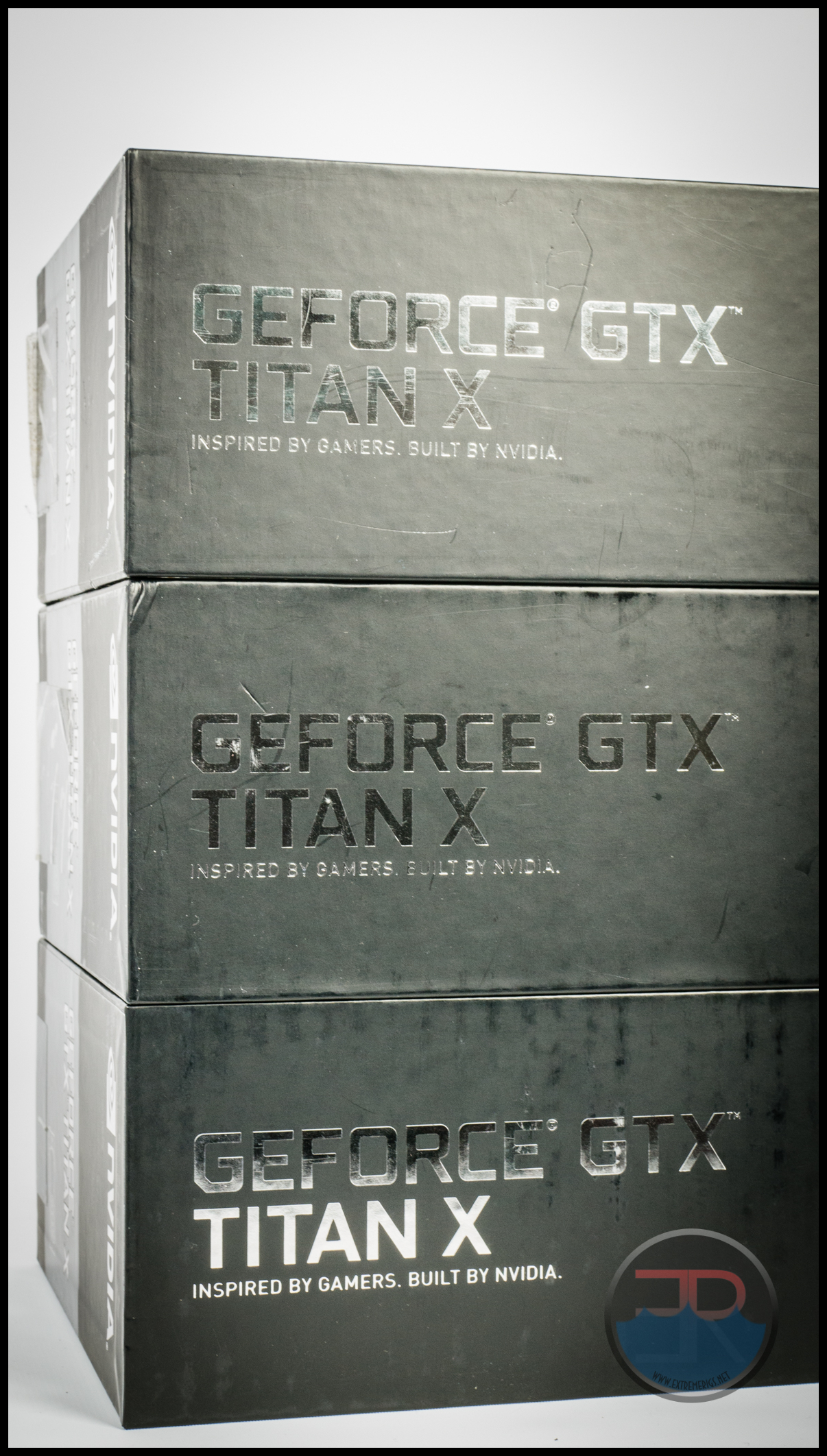
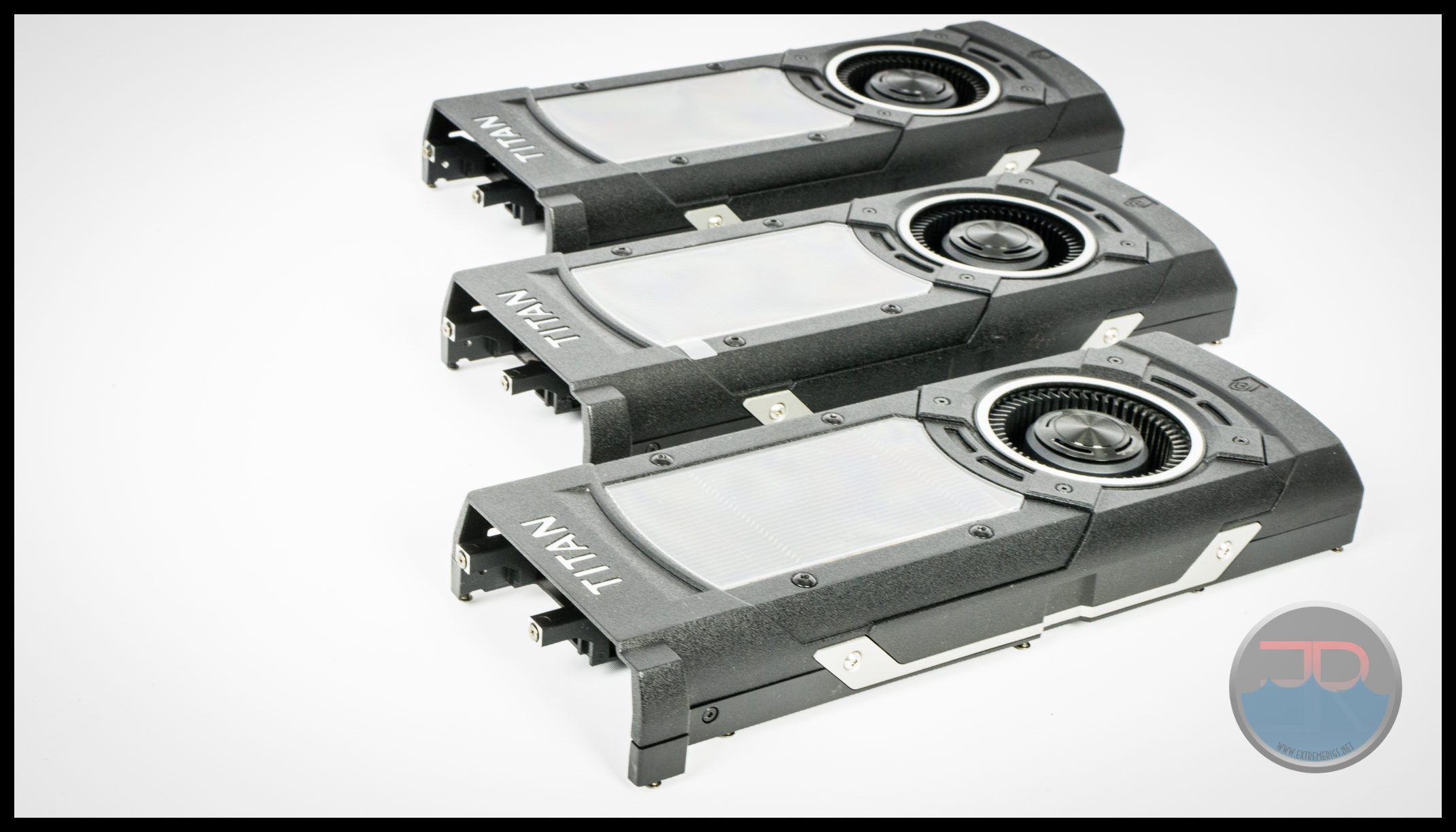
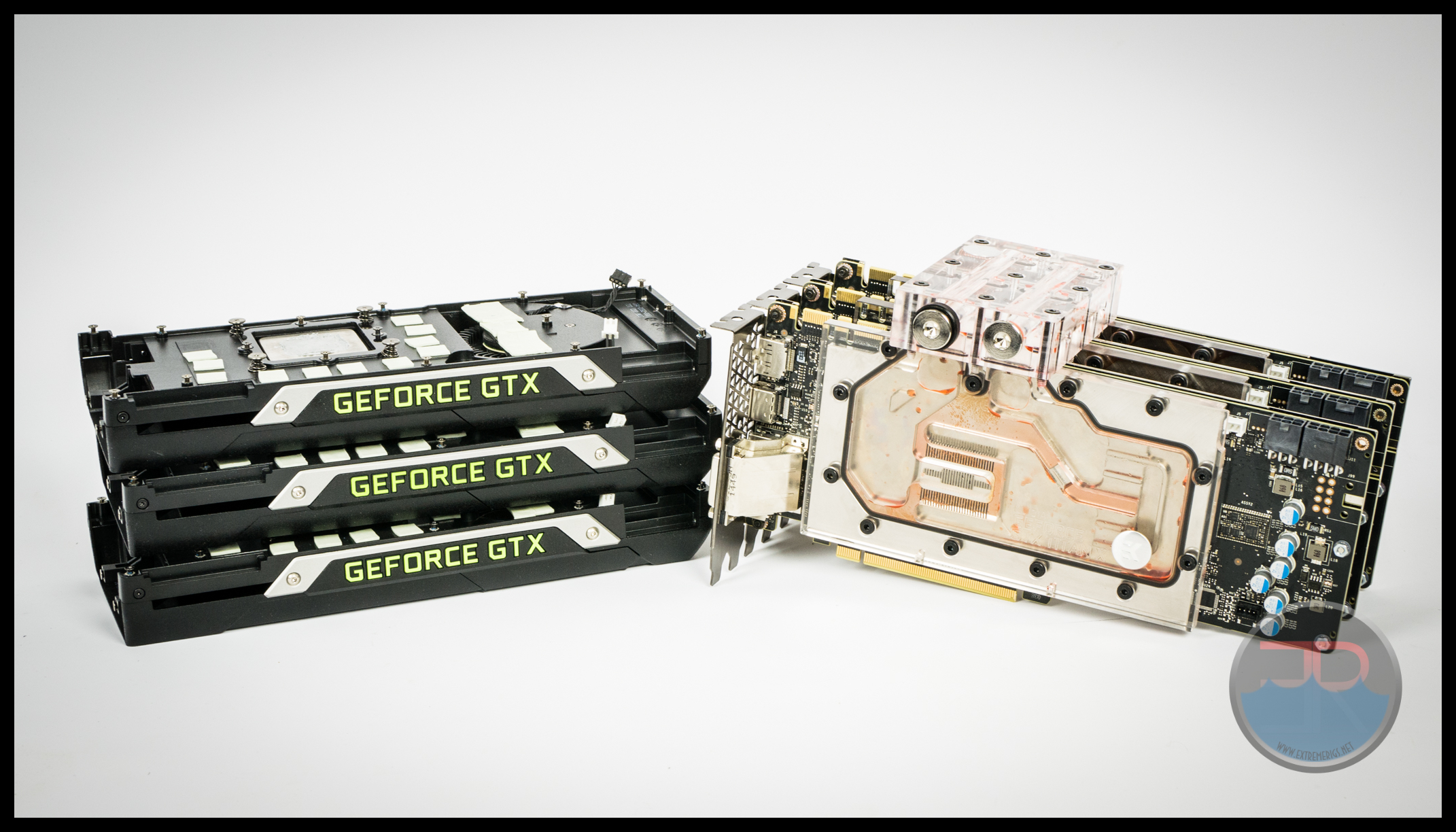
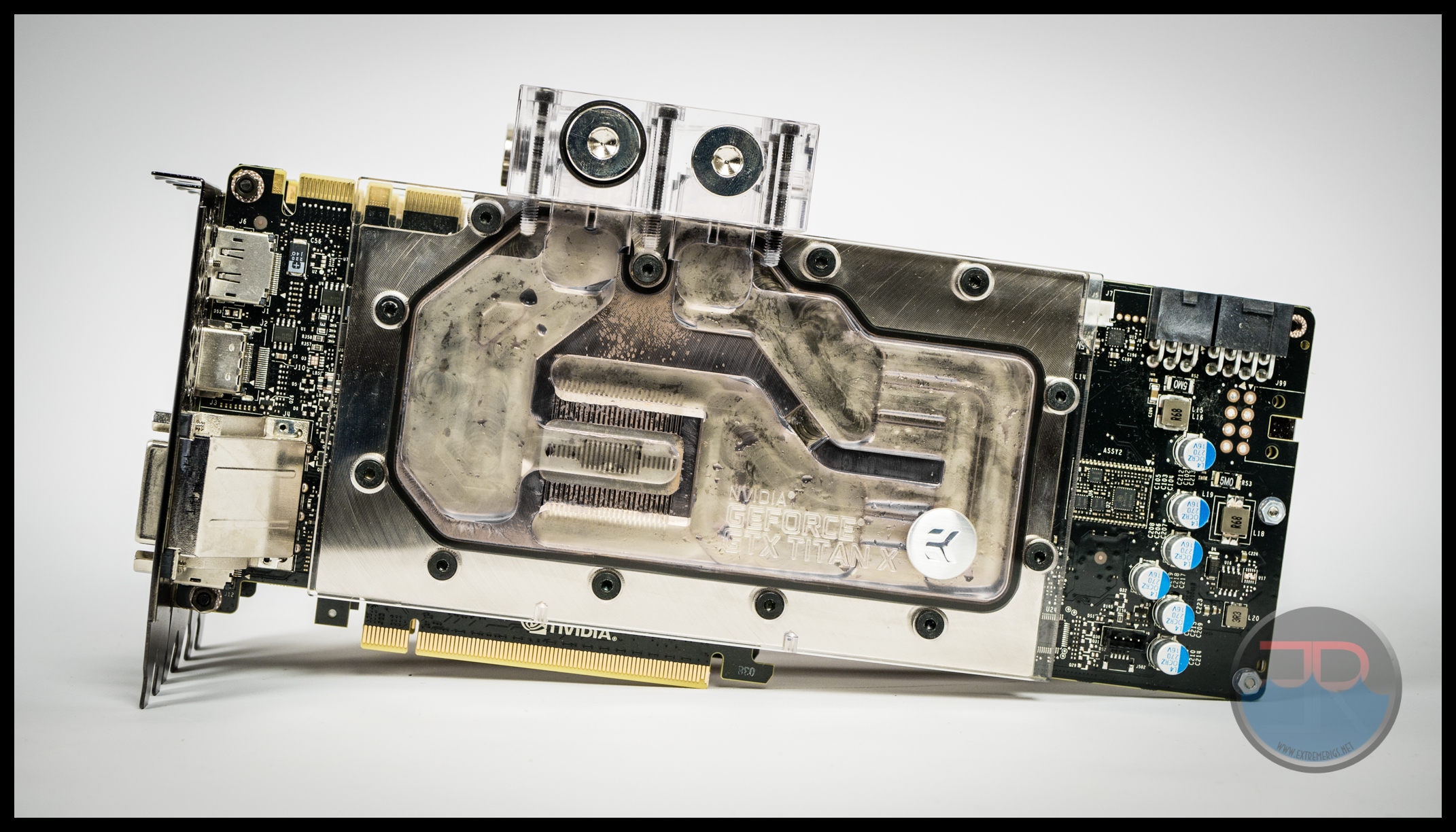
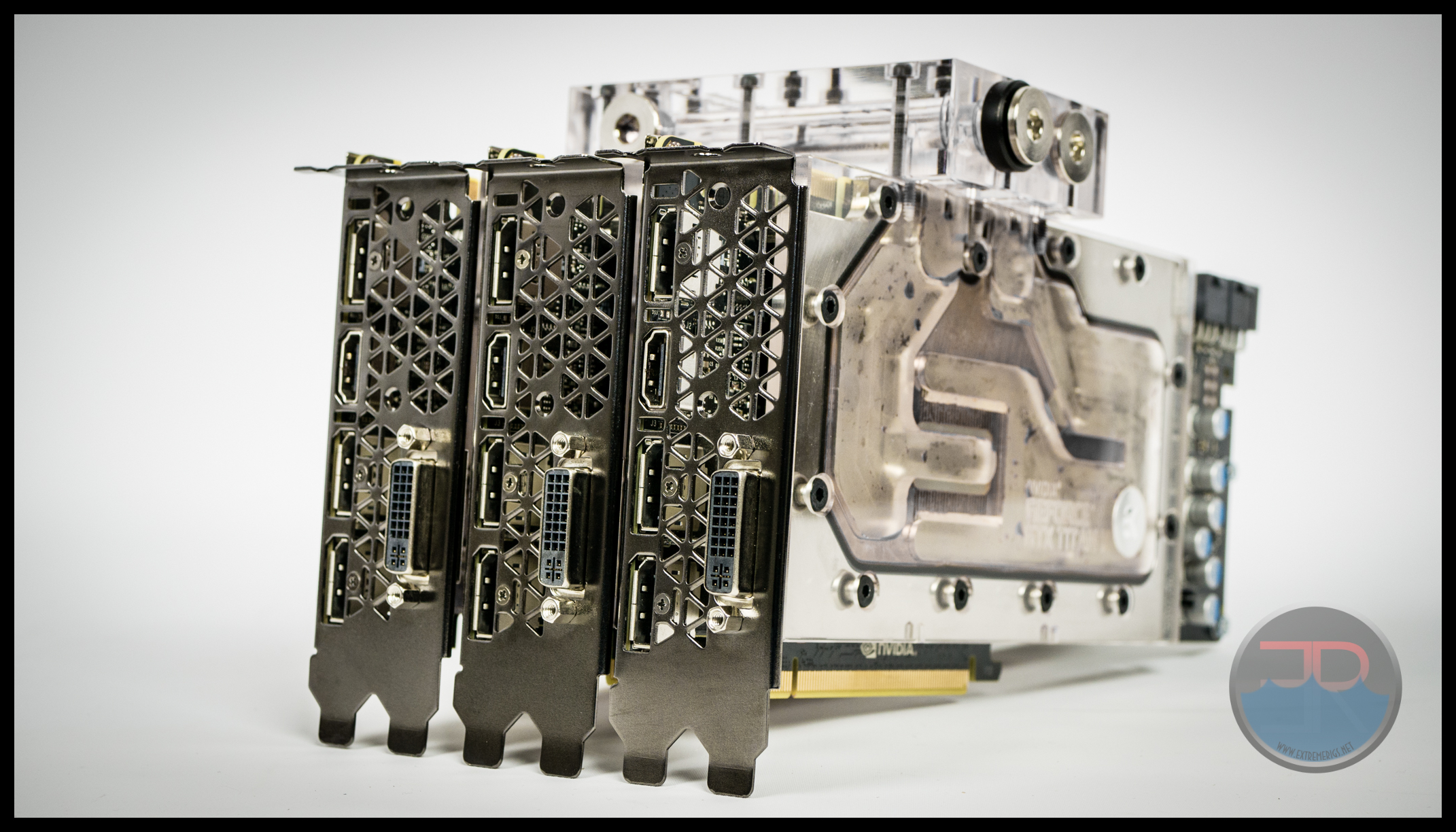
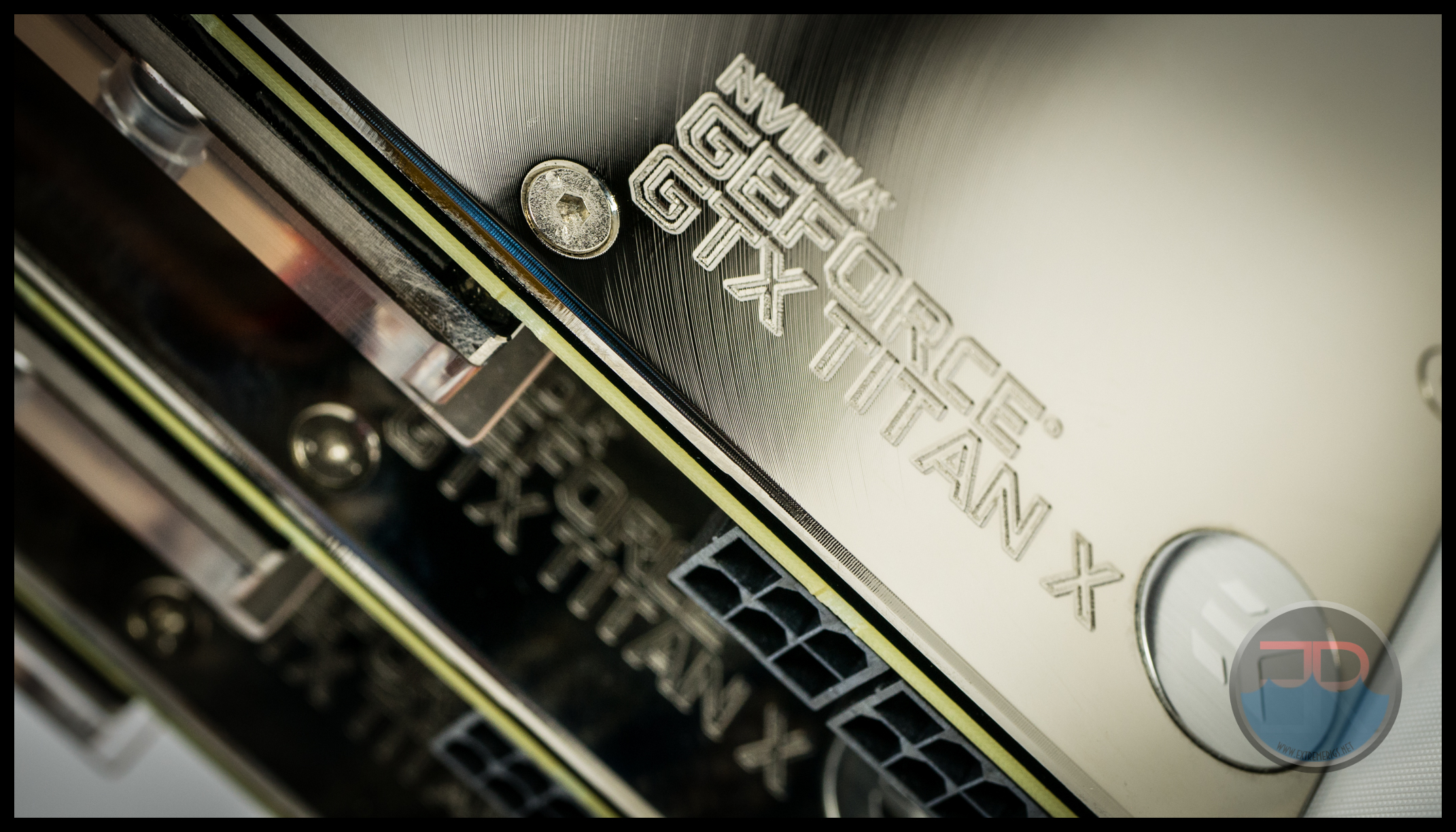
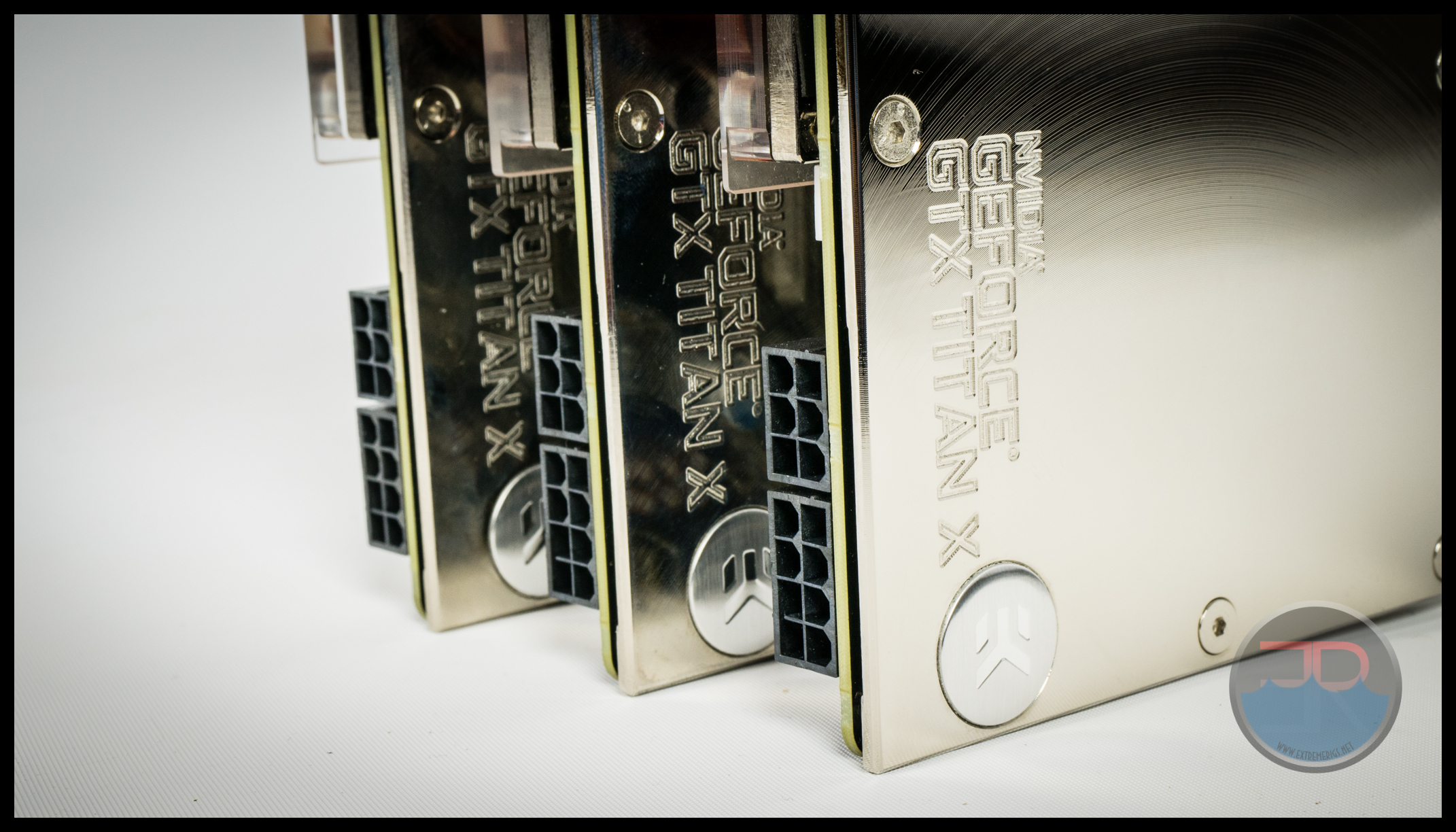
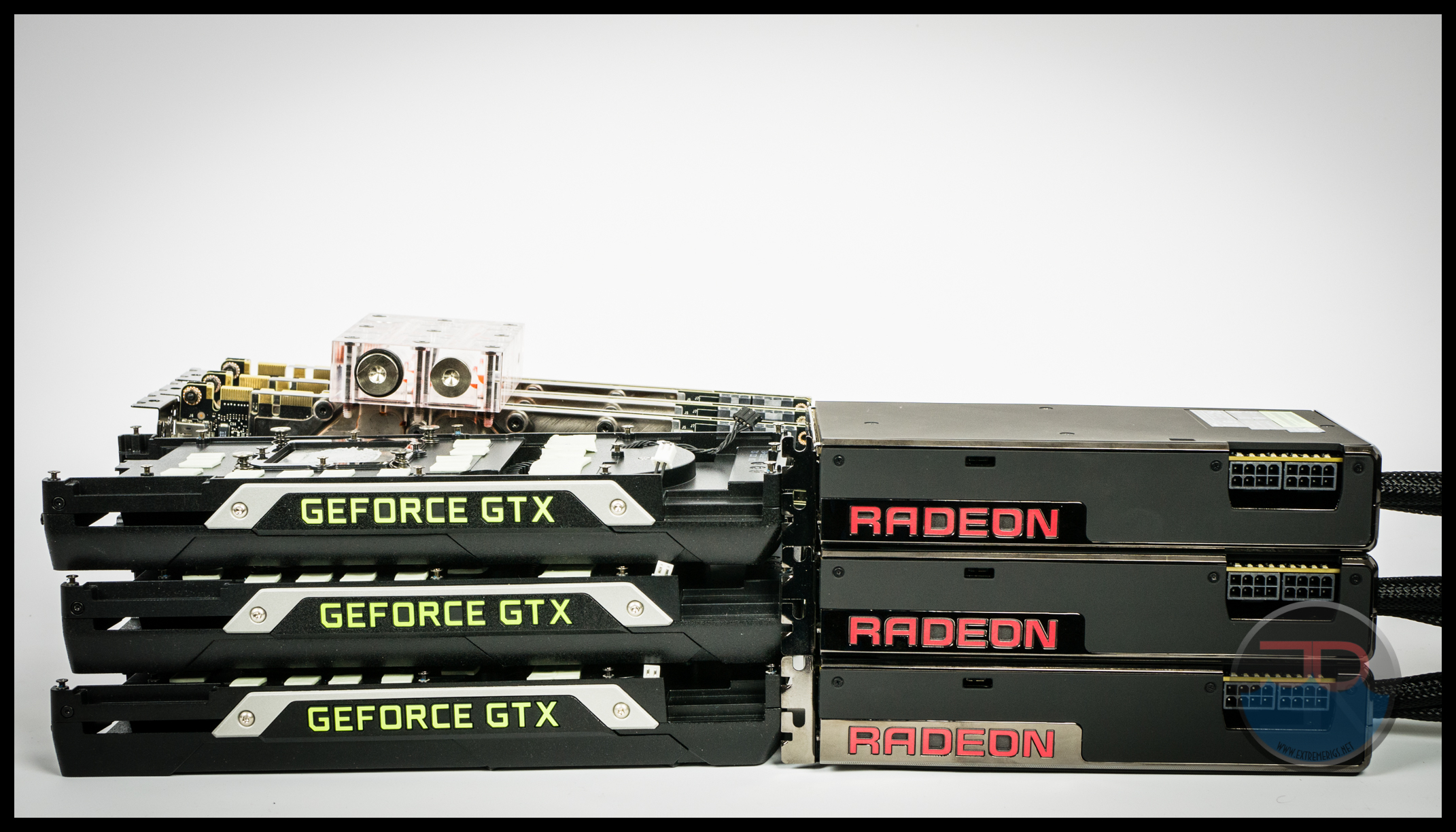
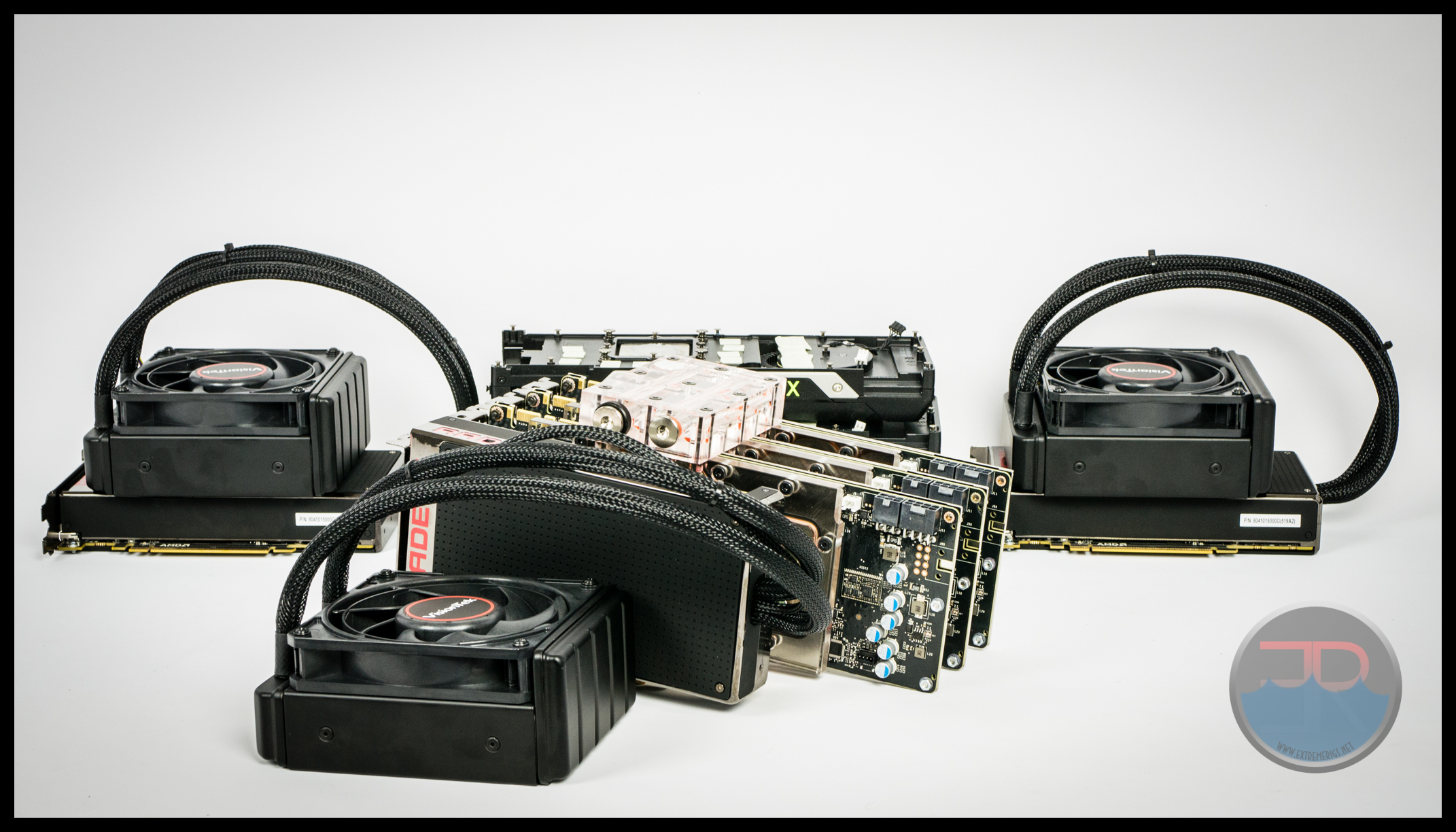





To be honest, I started reading this article with a thought that “well, how good can it be? ERs are watercooling guys so, nah! can’t expect too much”. But after reading the whole of it, I have to say, This is by far the one of the best comparative reviews I’ve ever seen, and really met all my expectations. Hats off to you guys!
Say, FuryX did have the claim in its pre-release rumor to be a TITAN X competitor, but then AMD shrunk that note to 980 Ti. So I think comparison with 980 Ti would’ve been better comparison (and seat clenching brawl) than this, and the clock-to-clock performance metrics but nonetheless, this is wayy too good also!
About capping the vRAM on FuryX in few games there, it also suffers from similar performance degradation on 4K and downwards. And as you may have seen on other reviews, FuryX does worse in sub-4K than the competition and even worse in 1080p. I’ve dug through every review out there yet haven’t found the reason behind this. What could be the reason?
And that scaling on nVidia – you know nvidia does claim that their SLI bridge isn’t a bottleneck, and so it is proved here :P. When AMD did introduce XDMA, I had this belief – AMD took the right path, bridges will suffer from less bandwith sooner or later, and PCIe already has the room for accommodating the data of the bridges. So XDMA did (well, now it is “do” :D) makes sense!
But it’s sad to see AMD not delivering smoother experience overall. If they could handle that thing, this should certainly deserved the choice over any of those higher average FPS of Titan X. But I think AMD is working on Win10 & DX12 optimized drivers and trying to mend it with bandages for now.
My only complain was the choice of TitanX over 980 Ti and clock-to-clock performance, but other than this, this is a very great review! Hats off to you again!
Agreed with Frozen Fractal. I was more than pleasantly surprised with the quality of this review, and I hope you continue to do these more in the future. A 980 Ti would have been nice to see too given the price.
Keep up the great work!
Thanks! I agree the 980 TI would have been a better comparison – then prices would have lined up. “Sadly” we only had Titan X’s and we weren’t willing to go out and buy another 3 GPUs to make that happen. However if anyone wants to send us some we’d gladly run em haha. I was simultaneously impressed with AMD’s results while saddened that after all the work on frame pacing that things still aren’t 100% yet. Hopefully
Question…you overclocked the Titan X to 1495MHz which is “ok” for a water cooling build. I won’t complain…though I’m surprised at why that’s all you were able to achieve as I can pull that off on Air right now (blocks won’t arrive until next week). Main question though…why wasn’t the memory overclocked? A watercooled Titan X has room to OC the memory by 20%, bumping up the bandwidth to 400Gbps, which brings it quite a bit closer to the 512Gbps of the HBM1 in the Fury X.
Although we didn’t mention it the memory was running a mild OC at 7.4Gbps up from the stock 7gbps
6gbps – so yes about the same as your 20%
This is what concerns me about your understanding of overclocking. The Titan X memory is 7GHz at stock. At 7.4GHz you’re only running a 5.7% OC on the memory…
Hah you’re right, I was looking at titan stock memory settings not titan x. Yes it could have been pushed harder. Still though single Titan X was really good compared to Fury X – the issue it had was scaling. So unless scaling is significantly effected by memory bandwidth then I don’t think it changes the overall results much. When we re-run with overclocked furies we’ll spend a bit more time on the Titan X overclock too.
Don’t get me wrong…SLI scaling is definitely an issue and will still exist regardless. But you’d be surprised how important memory clocks can be depending on the test you’re running. I found this out when I was running the original GTX Titan Tri-Sli in the overclock.net unigine valley bench competition and came in second place. Leave the official redo for your next review of Fury X OC vs Titan X OC, as you mentioned. But to satisfy your own curiousity, try a higher memory clock and see what happens. If you were looking to squeeze out every last ounce out of your Titan X, you should check out http://overclocking.guide/nvidia-gtx-titan-x-volt-mod-pencil-vmod/ as well.
My Phobya nanogrease should be coming in tomorrow so I’ll finally be putting my blocks on as well. I’m going to compare my performance results with yours next time you run your benches. So make sure you do a good job.
Excellent review. I am also running an Asus Rampage Extreme V with a 5960x OC’d to 4.4Ghz so your data really was telling. I’m running a single EVGA GTX980TI SC under water. I previously ran 2 Sapphire Tri-X OC R9 290s under water but opted to go with the single card.
Did you use a modded TitanX bios? What OCing tool did you use to OC the TitanX. I would like to try to replicate the parameters and run the single 980TI to see how close I am to your single TitanX data. Thank you.
Eh, i don’t really see the point of running AA in 5K Too bad it’s 5K btw, 4K is more reasonable. Too bad Fury X has problems with the Nvidia titles(W3 for example).
Too bad it’s 5K btw, 4K is more reasonable. Too bad Fury X has problems with the Nvidia titles(W3 for example).
But man, the scaling and texture compression on amd cards are absolutely amazing. If only they weren’t bottlenecked by the HBM1’s 4GB of VRAM.
[…] Review: Titan X vs Fury X in a Triple CFX SLI Showdown […]
[…] Review: Titan X vs Fury X in a Triple CFX SLI Showdown […]
[…] Review: Titan X vs Fury X in a Triple CFX SLI Showdown […]
Comments are closed.